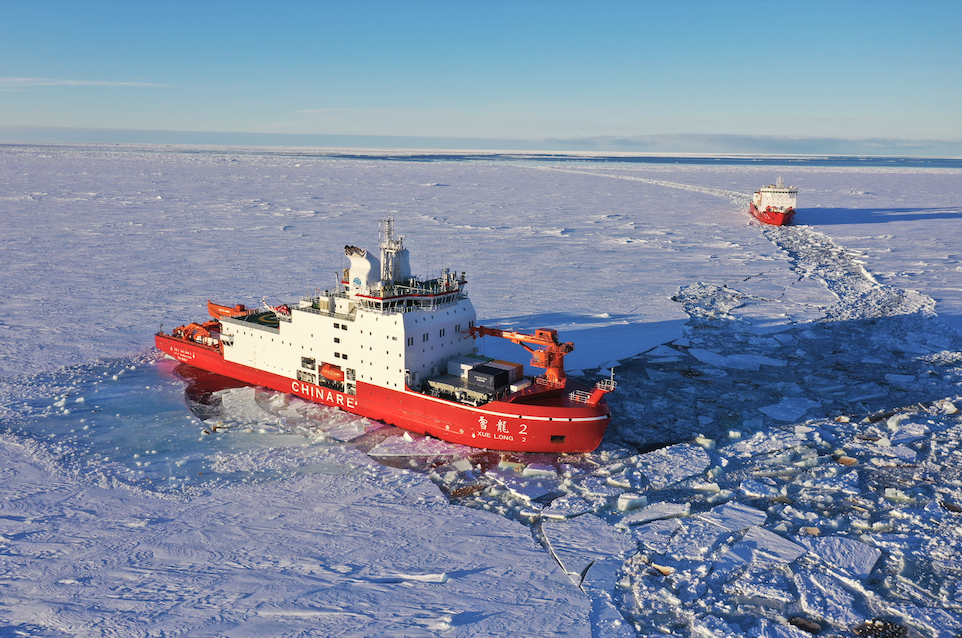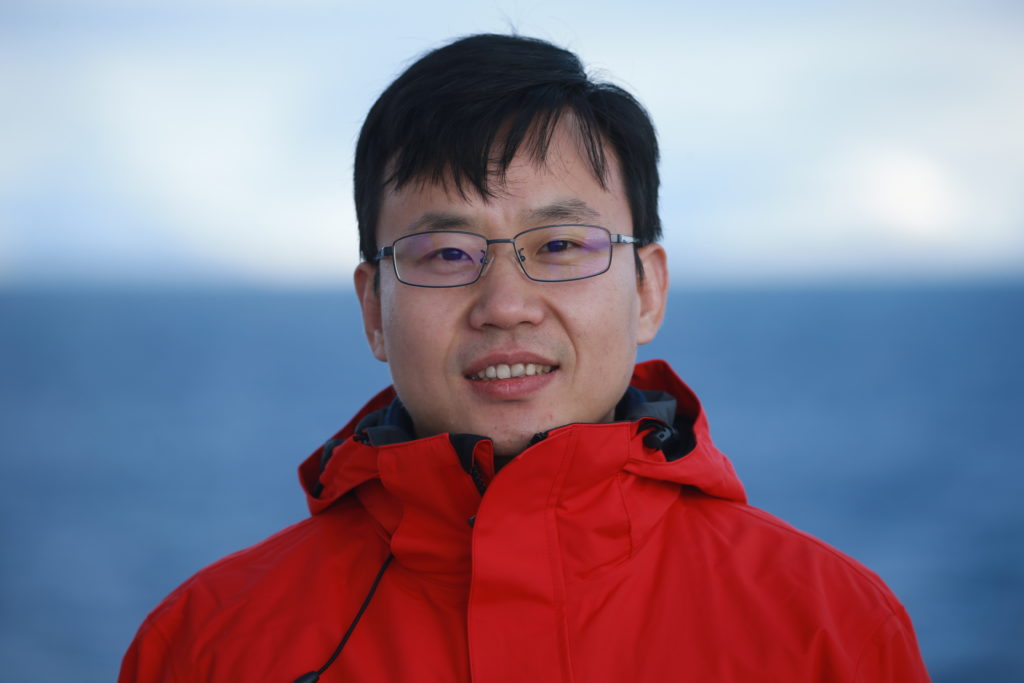
story by Helen Hill for MITgcm
Towards reconstructing long-term Antarctic sea-ice thickness and volume through sea-ice data assimilation
A team, bringing together researchers from China, Europe, and the US, use MITgcm to develop a new data assimilation system for the Southern Ocean with the aim of improving sea-ice thickness estimates in the region.
Finding large uncertainties in Antarctic sea ice thickness among several reanalysis tools (including GECCO2 and SOSE) [Shi et al, (2021)], Hao Luo, Qinghua Yang, and Dake Chen, from the School of Atmospheric Sciences, Sun Yat-sen University, and Southern Marine Science and Engineering Guangdong Laboratory Zhuhai, China; Longjiang Mu, Xiangshan Tian-Kunze, Lars Nerger, and Lars Kaleschke from the Alfred Wegener Institute, Helmholtz Centre for Polar and Marine Research, Bremerhaven, Germany; and Matthew Mazloff at SCRIPPS, have developed an ensemble-based Data Assimilation System for the Southern Ocean (DASSO) based on a regional sea ice–ocean coupled implementation of MITgcm, which assimilates sea-ice thickness together with sea-ice concentration derived from satellites. A paper describing their work appears in The Journal of Glaciology.
“Antarctic sea ice is a crucial component of the climate system,” explains Qinghua Yang. “In contrast to the rapid sea-ice decline seen in the Arctic, over the past 4 decades, the sea-ice extent of the Antarctic has exhibited an overall positive trend until 2015, but an abrupt decline since then.” Trying to understand the reasons for this in a region notorious for limited in-situ data prompted the team’s search for an improved ocean-sea-ice data assimilation model but when they looked, Antarctic sea-ice estimates from existing ocean–sea-ice coupled reanalysis tools showed poor agreement.
Yang says, “Although Antarctic sea-ice concentrations (SIC) can now be successfully measured using satellite-based passive microwave instruments, difficulty remains retrieving Antarctic sea-ice thicknesses (SIT) from satellites. As a result of limited SIT data, previous investigations primarily focused on the change in sea-ice extent or area rather than sea-ice volume. However, SIT, which determines the sea-ice storage of heat and freshwater, is clearly also a significant parameter. DASSO seeks to provide improved estimates of both SIT and SIC.”
To validate the performance of their new tool, the team conducted experiments using six months of data from mid-April to mid-October 2016. In general, the team found that DASSO’s assimilation of SIC and SIT was able to suppress the overestimation of sea ice seen in their model-free run. They also report that uncertainties in the operational atmospheric forcing data aside, applications of a covariance inflation procedure in their data assimilation method further improved their simulation of Antarctic sea ice, especially SIT.
Yang says, “Our results demonstrate the effectiveness of assimilating sea-ice observations in reconstructing the state of Antarctic sea ice, but also highlight the necessity for more reasonable error estimation for the background as well as the observation. With new satellite data sets coming online (the experimental Antarctic CryoSat-2, as well as forthcoming Antarctic ICESat-2 SIT data), the prospects look bright for reconstructing long-term Antarctic SIT and volume through sea-ice data assimilation.”
To find out more about this work contact Qinghua
Story image credit: Xuelong 2 (left) and Xuelong sailing in the Antarctic sea ice in November 2019. Figure courtesy of Junyi Chen.
About the Researcher

Qinghue Yang began using MITgcm in 2009. “With MITgcm, my colleagues and I have built the first Chinese Arctic Sea Ice Prediction System in 2010, and we started to offer sea ice service for the Chinese Arctic and Antarctic expedition cruises since 2010.,” he says.” Now we still use MITgcm in the Arctic and Antarctic sea ice-ocean numerical modeling, data assimilation and prediction. “
Related
Arctic Shipping Forecast MITgcm News
北极海冰数值预报的初步研究!!!MITgcm基于海冰!海洋耦合模式!”# $ MITgcm News
This Month’s Featured Publications
- Hao Luo, Qinghua Yang, Longjiang Mu, Xiangshan Tian-Kunze, Lars Nerger, Matthew Mazloff, Lars Kaleschke and Dake Chen (2021), DASSO: a data assimilation system for the Southern Ocean that utilizes both sea-ice concentration and thickness observations, Journal of Glaciology, doi: 10.1017/jog.2021.57
- Qian Shi, Qinghua Yang, Longjiang Mu, Jinfei Wang, François Massonnet, and Matthew Mazloff (2021), Evaluation of sea-ice thickness from four reanalyses in the Antarctic Weddell Sea, The Cryosphere, doi: 10.5194/tc-15-31-2021
Other New Publications this Month
C.H. Ainsworth et al (2021), Ten Years of Modeling the Deepwater Horizon Oil Spill, Science Direct, doi: 10.1016/j.envsoft.2021.105070
Constantin W. Arnscheidt, John Marshall, Pierre Dutrieux, Craig D. Rye, and Ali Ramadhan (2021), On the settling depth of meltwater escaping from beneath Antarctic ice shelves, Journal of Physical Oceanography, doi: 10.1175/JPO-D-20-0286.1
Ganesh Gopalakrishnan, Bruce D. Cornuelle, Matthew R. Mazloff, Peter F. Worcester, and Matthew A. Dzieciuch (2021), State estimates and forecasts of the northern Philippine Sea circulation including ocean acoustic travel times, Journal of Atmospheric and Oceanic Technology, doi: 10.1175/JTECH-D-20-0178.1
Shaojian Huang and Yanxu Zhang (2021), Interannual Variability of Air–Sea Exchange of Mercury in the Global Ocean: The “Seesaw Effect” in the Equatorial Pacific and Contributions to the Atmosphere, Environmental Science & Technology Article ASAP, doi: 10.1021/acs.est.1c00691
Kenneth G. Hughes, James N. Moum, Emily L. Shroyer, and William D. Smyth (2021), Stratified shear instabilities in diurnal warm layers, Journal of Physical Oceanography, doi: 10.1175/JPO-D-20-0300.1
Masa Kageyama et al (2021), The PMIP4 Last Glacial Maximum experiments: preliminary results and comparison with the PMIP3 simulations, Climate of the Past, doi: 10.5194/cp-17-1065-2021
Alok Kumar Mishra et al (2021), Impact of horizontal resolution on monsoon precipitation for CORDEX-South Asia: A regional earth system model assessment, Science Advances, doi: 10.1016/j.atmosres.2021.105681
Li, J., Zhang, Q., and Chen, T. (in review 2021), ISWFoam: A numerical model for internal solitary wave simulation in continuously stratified fluids, Geosci. Model Dev. Discuss., doi: 10.5194/gmd-2021-102
Shouwei Li, Wei Liu, Kewei Lyu & Xuebin Zhang (2021), The effects of historical ozone changes on Southern Ocean heat uptake and storage, Climate Dynamics, doi: 10.1007/s00382-021-05803-y
Luo H, Yang Q, Mu L, TianKunze X, Nerger L, Mazloff M, Kaleschke L, Chen D (2021), DASSO: a data assimilation system for the Southern Ocean that utilizes both sea-ice concentration and thickness observations, Journal of Glaciology, doi: 10.1017/jog.2021.57
Louise Rousselet, Paola Cessi, Gael Forget (2021), Coupling of the mid-depth and abyssal components of the global overturning circulation according to a state estimate, Science Advances, doi: 10.1126/sciadv.abf5478
Callum J. Shakespeare, et al (2021), Lagrangian Filtering: A novel method for separating internal waves from non-wave flows in high-resolution simulations, ESSOAr (under consideration at Journal of Advances in Modeling Earth Systems, doi: 10.1002/essoar.10507016.1
Callum J. Shakespeare, Brian K. Arbic, and Andrew McC. Hogg (2021), Dissipating and reflecting internal waves, Journal of Physical Oceanography, doi: 10.1175/JPO-D-20-0261.1
Shakespeare, C. J., Arbic, B. K., & McC. Hogg, A. (2021), The impact of abyssal hill roughness on the benthic tide, Journal of Advances in Modeling Earth Systems, doi: 10.1029/2020MS002376
Simon D.A. Thomas et al (2021), Defining Southern Ocean fronts using unsupervised classification, Ocean Sci. Discuss., doi: 10.5194/os-2021-40
Michael D. Tyka, Christopher Van Arsdale, and John C. Platt (2021), CO2 capture by pumping surface acidity to the deep ocean, EarthArXiv, https://eartharxiv.org/repository/view/2313/ doi: 10.31223/X5TK60
Von Albedyll, L., Haas, C., and Dierking, W. (2021), Linking sea ice deformation to ice thickness redistribution using high-resolution satellite and airborne observations, The Cryosphere, doi: 10.5194/tc-15-2167-2021
Xiaoting Yang, Eli Tziperman (2021), South Atlantic deep eastern boundary current driven by Agulhas rings: An idealized study, Ocean Modelling, doi: 10.1016/j.ocemod.2021.101817
Yadidya, B., Rao, A.D. & Mohanty, S. (2021), Simulation of diurnal variability in vertical density structure using a coupled model, Scientific Reports, doi: 10.1038/s41598-021-90426-w
Madeleine K Youngs, Glenn R Flierl (2021), Three-dimensional Overturning Circulation Generated by Topography in the Southern Ocean and Its Implications, ESSOAr (under consideration for Journal of Geophysical research – Oceans), doi: 1002/essoar.10507031.1
Wei, H., & Wang, Y. (2021), Full-depth scalings for isopycnal eddy mixing across continental slopes under upwelling-favorable winds, Journal of Advances in Modeling Earth Systems, doi: 10.1029/2021MS002498
Xixi Wen, Shiqiu Peng, Yu-Kun Qian, Yineng Li (2021), Diversity in Vertical Structures of Internal Tide Dissipation Rate Around the Indonesian Throughflow Exits Simulated by a High-Resolution Nonhydrostatic Model, Geophysical Research Letters, doi: 10.1029/2021GL092706
Do you have news about research using MITgcm? We are looking for contributions to these pages. If you have an interesting MITgcm project (ocean, atmosphere, sea-ice, physics, biology or otherwise) that you want to tell people about, get in touch. To make a post, contact Helen
